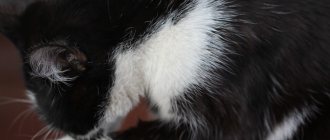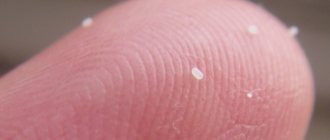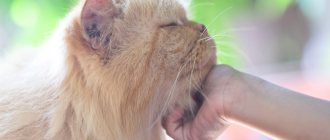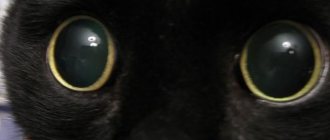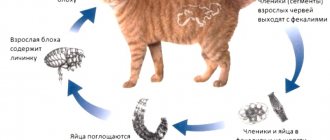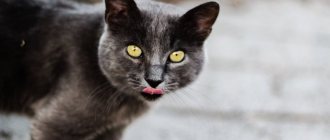List and description of possible causes
It’s rare that owners bring their cat to the veterinarian complaining that it has black specks in its fur. Usually they complain of severe itching and non-healing wounds after severe scratching. If these and other symptoms are present, the following diseases should be excluded:
- Demodecosis. Contrary to the erroneous opinion of some veterinarians, this disease still affects cats, although much less frequently than dogs. Demodex (Demodex cati) is considered a habitual inhabitant of the skin and normally does not cause any pathological manifestations. His activity is always provoked by something. Usually these are recent diseases of the internal organs, the postoperative period, prolonged use of antibiotics or severe hormonal fluctuations. All this manifests itself in the appearance of black grains in the cat’s fur, which are not accompanied by itching. It is important! But demodicosis causes the appearance of large bald spots (in severe cases, even partial baldness), in place of which small black dots appear. There is also the concept of juvenile demodicosis, which occurs in kittens aged 2-6 months. It usually affects the chin and flexor limbs. In most cases, it goes away on its own without the use of any medications. It is noted that demodicosis occurs more often in decorative breeds (Scots, British, Sphynx, Siamese).
- Flea dermatitis. Another reason why a cat may have black spots under its fur. A distinctive feature is that the parasites themselves may not be on the animal, since one bite is enough to provoke an allergic reaction to the flea’s saliva. The pet begins to behave restlessly, scratching its ears or chin (most often).
- Food allergies. A common phenomenon among decorative breeds. The slightest disturbance in the diet can provoke a severe allergic reaction, which manifests itself in the appearance of black grains in the fur, flaking, redness and hair loss (in some cases in clumps). The allergen is determined by exclusion, but most often the owners have to solve the problem for life with the help of drugs against itching and inflammation.
- Fleas. A real nightmare for cats of all ages. Even if you don't see them on your pet, it doesn't mean that fleas aren't biting him. You can get infected from other animals (dogs) or through objects brought from the street (even the soles of your shoes can have parasites). There are many cases when fleas were brought home along with the grass that cats love to eat in the spring and summer. At first, you may notice that your pet begins to itch more than usual (most attention is paid to the face). Over time, you may notice the appearance of black grains of sand under the fur, which fall off the animal after each stroking or combing. Large bald patches begin to appear due to scratching. In these places, brown-black crusts form on the skin due to claw wounds. The most correct solution would be to immediately treat all animals that have access to each other with anti-parasite drugs. Drops on the withers of Stronghold and Frontline are excellent against fleas and ticks. Process 2 times a month. Much attention is paid to the disinfection of housing, which is carried out using Parastop.
- Bacterial damage. A common occurrence in animals predisposed to allergies. Constant itching leads to deep calculations through which infection enters. Wounds can fester and take a long time to heal. Using cytology, the pathogen is determined and effective anti-inflammatory drugs are selected. In severe cases, antibiotic therapy is used.
- Dermatophytosis. A fungal infection that affects the cat's fur and skin. Small black grains and redness can be found at the site of the lesion. As the process progresses, the affected area transforms into a weeping wound the size of an egg. Severe itching leads to deep scratching and the process spreading to other parts of the body. Most often, pets who have free access to the street and, accordingly, to stray animals suffer. To confirm the diagnosis, a deep pluck is taken from the lesion for microscopic examination. This area can also be illuminated under a Wood's lamp, which will show a bright green glow if there are fungal spores in the fur. Treatment is long, with the use of antifungal drugs in the form of tablets, ointments and shampoos. To avoid relapse, all places with which the infected animal comes into contact are thoroughly washed with water and bleach and chlorhexidine.
Symptoms of parasite infestation
Infection with each group of parasites has its own special symptoms. For ectoparasites this is:
- the appearance of small red spots on the cat’s skin (reaction to flea bites);
- formation of scratches - the cat constantly itches and tries to gnaw insects out of its fur;
- skin diseases (dermatitis) develop;
- the occurrence of baldness;
- the development of anemia (anemia) - occurs especially quickly in kittens, this can be understood by looking at the oral mucosa (it turns pale);
- change in behavior - the cat becomes irritable and aggressive;
- decreased appetite;
- deterioration in wool quality;
- in the presence of ear mites, the appearance of greenish tubercles and severe dirt in the cat’s ear.
You have to look for ixodid ticks on a cat's skin manually, carefully examining and feeling it.
External parasites can lead to dire consequences
Symptoms of internal parasite infestation:
- general cat malaise;
- dulling of fur;
- alternating constipation and bloody diarrhea;
- accumulation of dry crusts in the eyes of the animal;
- loss of appetite;
- weight loss or exhaustion;
- vomit;
- anemia;
- increased body temperature;
- the appearance of convulsions caused by intoxication from the decaying bodies of dead worms and their waste products;
- developmental delay in kittens;
- bloating and tightness of the abdomen;
- development of wheezing and coughing, asthmatic attacks in the presence of pulmonary and heartworms;
- the appearance of worm bodies in feces.
If any of these signs are present, contact your veterinarian immediately.
Often, when infected with parasites, apathy and malaise are observed.
Flea - appearance, structure, symptoms
Fleas are found everywhere. This is a fairly large order of insects, which includes subspecies that feed on cat, dog, rat and even human blood. They differ from each other in size, color of the chitinous cover and some features of the body structure.
What does a cat flea look like?
The cat flea is one of the most common and small species among the flea order. The size of an adult insect rarely exceeds 3 mm. For comparison, fleas that feed on human blood have body sizes of up to 5 mm, and moose fleas often reach a length of 12 cm! They move quite quickly on the animal’s body, as they are perfectly adapted for movement in thick fur. They have a body that is flattened laterally, allowing them to maneuver between hairs, and long hind legs, with the help of which fleas are able to make jumps up to half a meter long.
The color of a cat flea can vary from light red to dark brown. Sometimes there are almost black insects that are practically invisible in the fur of an animal with a dark color. Upon closer examination, one can discern light stripes on the abdomen that form at the joints of the abdomen. They become most noticeable when the insect is saturated, when its body increases in size.
What does a flea look like on a cat's body? Outwardly, they look like large grains of dirt stuck in the fur, and only at the moment of their movement it becomes clear that these are insects. A lot of deception is facilitated by flea excrement remaining on the skin of the animal, which is sometimes mistaken for insect eggs.
Flea larvae are not at all similar to adult insects. Outwardly, they look like legless and eyeless dark-colored worms with sparse bristles on the segments of their body. They are very small, no more than 6 mm in length and 1-2 mm in thickness. Unlike adult fleas, larvae do not feed on blood and live outside the animal’s body, in the folds of upholstery of upholstered furniture, carpet pile, and cracks in ceilings.
Flea eggs are small, white, about 0.5 mm long. Females lay them on the floor of the room, where they further develop to the larval stage. Flea eggs look like grains of semolina stuck to your finger:
Interesting fact! Fleas do not live on animals permanently. They only feed on their blood, but live on the floor of the room, in all sorts of cracks and in the upholstery of furniture.
Body structure
If you look at a flea from a close distance, you can see that its entire body is covered with numerous bristles and spines. They help the insect stay on the animal's body. The bristles are located over the entire surface of the body, on the limbs, back, and head. At the ends of the legs, 2 claws are also clearly visible; with their help, the flea moves in the thick undercoat. The hind legs are well developed and consist of 5 segments. The forelimbs are somewhat shorter, they do not participate in jumping and are mainly adapted for moving along the animal’s fur.
Female fleas are usually somewhat larger than males due to their voluminous abdomen, where they carry their eggs for the time being. In the back of the body in both sexes there is a peculiar tactile organ equipped with sensitive hairs.
Symptoms of fleas
- on the back;
- near the ears;
- in the armpit;
- on the skin in the chest and cervical area of the body.
Cats can seriously damage their skin when trying to get rid of insects. Microbes get into the wounds, which in some cases leads to inflammation of the skin and the development of all kinds of dermatitis.
If you suspect that there are fleas in the house, first check the animal's skin. As a rule, insect waste products can be found on it - black lumps of digested blood. When rubbed between your fingers, they break up into small particles. There are usually quite a lot of such traces left in the thick undercoat. In shorter and less dense hair there are fewer of them, since they are combed by the animal onto the floor, where they become food for flea larvae.
Interesting fact! After saturation, fleas jump off the animal and hide in floor cracks or other hard-to-reach places. The next “feeding” occurs no earlier than in a day.
Symptoms of acne
The following symptoms are typical for this disease:
- Redness of the skin;
- The appearance of swelling in the area where blackheads accumulate;
- Development of ulcers, hair loss;
If left untreated for a long time, these symptoms often cause anxiety, the pet becomes nervous and irritable, and may show aggression. In addition, the cat begins to scratch the damaged area, thereby increasing the risk of a new infection and deterioration in overall health.
An examination by a specialist and taking a scraping will help rule out the presence of diseases with similar symptoms. These include:
- Diseases of the stomach and liver. Caused by poor diet or complications after an illness. Lead to rashes all over the cat's body.
- Demodecosis. Characterized by the presence of subcutaneous mites. It is characterized by the appearance of ulcers, itching and hair loss. Easily transmitted to other animals.
- Allergy. Common causes are a reaction to food, collar, litter. It is characterized by the appearance of pimples or black spots in the cat’s fur, redness of the skin and itching.
- Ringworm. The development is provoked by a fungus, as a result of which peeling and rashes appear on the cat’s skin, which lead to itching and baldness.
In addition to the above reasons, a strong argument indicating the need for examination by a veterinarian is a deterioration in the pet’s general health, refusal to eat, vomiting, lethargy and constant drowsiness. After conducting a visual examination, the doctor will prescribe the necessary examination, which may include various tests - skin scraping, fungal exclusion analysis and biopsy.
Causes of fleas
- while walking in contact with an infected animal;
- through household items that have insect eggs and larvae on their surface;
- when adult insects are brought into the house on clothes or their larvae with dirt on shoes;
- from neighboring apartments where there are infected animals.
Do cat fleas bite people? A hungry flea attacks anyone who is nearby. There are no special restrictions in her diet, although she still prefers the blood of animals, and of a certain species. There is evidence that fleas attack people in the absence of their pets. Single bites can also be observed when the apartment is heavily infested with insects.
Fleas from cats are not transmitted to humans in the literal sense of the word. Insects only feed on animals and, accordingly, will not live on humans. However, they can migrate from place to place by jumping onto a person's clothing. This can happen if he walks near their habitat or pets an outdoor cat. Fleas can also move into the folds of clothing if a person picks up care items for an animal infested with insects.
Advice! To protect yourself from flea attacks, you need to carefully monitor the sanitary situation in your apartment - periodically wash the floor, wipe off dust, and wash dirty linen. It is in dust and piles of garbage that insects live and their larvae develop.
Fighting methods
Animal processing
- shampoos
- sprays
- drops
- collars
- pills.
Anti-flea shampoos that contain an insecticide have proven themselves to be excellent. With their help, you can get rid of insects on an animal in one go. They are relatively safe for cats and last quite a long time after treatment. However, shampoos are not always convenient to use, especially if your pet is afraid of water. In this case, you can use flea spray.
Insecticidal preparations in the form of a spray are applied to the surface of the cat's skin, and certain protective measures must be taken to protect both the animal and the person carrying out the treatment. The face is covered with a gauze mask, and gloves are put on the hands. It is best to wear a special collar on your pet, designed to prevent the animal from licking the drug from its fur. You also need to cover the cat's eyes, nose and mouth.
Flea drops are applied to the animal's withers. This is perhaps one of the easiest to use products and is most popular among cat owners. It effectively rids the animal of fleas and at the same time is practically safe for the animal, since the toxic substance is applied to an area of the body inaccessible to the cat’s tongue.
Collars serve more as a preventative measure of protection, repelling insects from the animal while it walks around the yard. They are valid for a limited time and must be changed periodically.
The tablets are intended for internal use. They are given to the cat with food or simply placed on the root of the tongue and, stroking the throat, force it to swallow. As a rule, tablets can be used from 3 months of age, however, the condition of the animal must be taken into account and the dosage must be strictly observed so as not to harm its health.
Vaccination is a relatively new way to rid pets of fleas. It is quite effective and lasts for a long time after injection. However, this method cannot be used on pregnant or lactating cats, as the active substance may affect the growth and development of kittens.
Advice! When choosing a flea drop, you need to carefully study its composition and make sure that it does not contain pyrmethrin, since this insecticide is contraindicated for use on cats.
Treatment of a young animal
How to remove fleas from a kitten? The peculiarity of processing a young animal is that there is always a danger of poisoning it with an insecticidal preparation. Small kittens under the age of two months are breastfed by their mother and any external product applied to their fur will be immediately licked off by her and then passed into the body of the cubs with milk. Therefore, mechanical processing methods are mainly used:
- combing the fur with a fine comb;
- catching insects by hand;
- bathing with herbal decoctions.
There are also special shampoos for younger kittens, but they can be used on babies who have already been weaned from their mother.
From 2 months, provided that the kittens are separated from their mother, the following drugs are used:
- shampoos for kittens;
- flea powder;
- spray.
Shampoos are diluted in accordance with the instructions and applied to the pet’s coat. After a certain time, it is washed off, and dead insects are combed out with a comb. The powder is rubbed into the kitten's skin using your fingers, and care must be taken to ensure that the kitten does not lick the product from the surface of the fur. The spray is first applied to the palms and then distributed over the scalp. When processing, you need to exercise some caution and not bring your hands with the drug to your face.
Starting from 3 months of age, when treating kittens, you can use almost all drugs intended for adult animals.
Apartment pest control
- aerosols;
- powder preparations;
- means in the form of solutions.
Aerosols give very fast and effective results. It is enough to treat the room with them once and you can forget about fleas for a long time. However, this type of insecticide has the following disadvantages:
Powders act for a longer time, however, you have to wait longer for the results from them. Disinsection with their help will require long-term wet cleaning to wash away traces of the insecticide from surfaces. Powder preparations are scattered or sprayed indoors, trying to pay special attention to possible insect habitats:
- cracks in the floor;
- corners of rooms;
- the space behind the baseboards;
- floor surfaces under cabinets, beds, sofas.
Liquid products are diluted in accordance with the instructions and applied to places where insects accumulate using a sprayer. You can also simply wash the floor in your apartment with them. When processing, the following personal safety measures must be observed:
- put rubber gloves on your hands;
- cover your face with a protective mask;
- do not consume food or drinks during disinsection;
- remove food and personal items.
Treatment with liquid products gives a good long-term effect, but it is quite labor-intensive and will require a significant investment of time.
- pseudotuberculosis is an acute infectious disease that, despite the name, has nothing to do with pulmonary tuberculosis;
- tularemia is a bacterial infection that affects the lymph nodes;
- brucellosis is an infection that affects multiple organs and systems of the human body;
- Dipylidiasis - infection with tapeworms.
In addition, it can cause allergic dermatitis; the itching at the bite sites is quite strong and lasts for several days, during which a person is able to scratch the bite site until it bleeds, which, in turn, can lead to infection directly into the wound.
>How do insects get into an apartment?
Fleas are unpretentious in everyday life; they love humidity, dampness, and dark, dusty places in the house. They feed on the blood of humans and animals.
Treating a cat for dandruff
To rid your pet of bran, you need to determine the reason that caused the increased exfoliation of dead skin particles. A small kitten can be very depressed by itching, so the investigation should not be delayed. You will probably have to deal with this for quite a long time: for example, if the cause is dry air in the apartment, then the problem requires a global solution.
Before going to a specialist with a question about how to treat dandruff in a cat , you can independently eliminate the cause of the phenomenon. Negative factors such as improper diet, inappropriate shampoo, and dry air can be easily corrected by owners without the intervention of a veterinarian, and additional drug treatment for back dandruff is not required.
It's worth asking yourself if your cat had something new in her diet after which dandruff was noticed. You can cure the attack by simply excluding the product from the menu.
global $ads_google; //data-ad-slot=”2475549904″ $ads_google = empty($ads_google) ? false : true; ?> if ($ads_google == false) {?>
$ads_google = true; ?> } ?>
If shortly before the “snowfall” the pet was given some kind of medicine from skin particles, this must be mentioned to the veterinarian during the examination. The doctor is even informed about procedures such as grooming performed in the salon and the latest treatment for parasites.
If it was not possible to eliminate the disease, then you should not try to become a veterinarian at home without special education: the doctor is much better able to detect a disorder in the cat’s body and prescribe appropriate effective treatment.
Anti-dandruff shampoo for cats
The first thing you should try after adjusting your diet is anti-dandruff shampoo. Such products function as antifungal, antibacterial and normalize the functioning of the sebaceous glands. The main active ingredients are zinc and salicylic acid. Thanks to their effect, the upper layer of skin is regenerated and wounds heal.
The most famous shampoo can be called a product called “Doctor” from TD Goodman. The advantages of the drug include the elimination of unpleasant odor, itching and allergic reactions. The shampoo is easy to foam and rinse off without leaving any residue, leaving the coat looking silky and shiny. If you want to get rid of skin flakes at once, then you should not hope for this - a noticeable effect is achieved in several applications over a long time.
Apply the shampoo to the coat and do not rinse off for 3-5 minutes. At this time, you should distract your pet and not let her try to lick the product.
It would be good if you consult a specialist before using the drug described above.
Professional-level shampoo from Anju Beauté is called super-cleansing. Its action is aimed at normalizing the functioning of the sebaceous glands, as a result the skin is degreased, the secretion of the sebaceous glands is reduced, and the coat itself is moisturized.
The composition contains nettle extract - the cat's coat will grow faster and look much neater and more beautiful.
The product is very economical - for washing it is used in a ratio of 1 to 5 with water.
Vitamins for cats against dandruff
In case of seborrheic revelry on the skin, a vitamin course will not be superfluous:
- Cat Felltop Gel with biotin and zinc is great for skin problems;
- Cat – Fell OK (Canina) – vitamin and mineral complex with an unlimited course of administration;
- Laveta Super for Cats (Beaphar) - thanks to vitamins B, E, biotin and taurine, the coat will become healthy and shiny.
- Derm Caps and Derm Liquid is an effective vitamin complex from German developers and is aimed at restoring the skin and improving the health of the coat;
Even the best vitamin complexes will not be able to help if the true cause of dandruff is not eliminated.
Anti-dandruff spray for cats
To treat dandruff in cats, you can use medicated sprays like Tropiclean Oxy-Med. This is a natural remedy with colloidal oatmeal, wheat germ proteins, vitamins B5 and E, and salicylic acid. All substances actively act on the affected area, healing both the skin and coat. Swelling is noticeably reduced and itching is eliminated, and the activity of the sebaceous glands is regulated.
Effective means
Collars
But you need to remember that the effect of the collar is limited in time, and it must be changed approximately every 3-4 months.
Flea shampoos
An effective flea treatment can be purchased at a veterinary pharmacy. Before use, you should carefully read the instructions, since the concentration of toxic substances in shampoos may differ from each other, so it is important to follow the recommendations on the volume that must be used to treat animal hair.
Flea drops
Insecticides
It is better to purchase toxic flea products for treating your garden plot, basement and premises from the sanitary and epidemiological service. You can also order the treatment of a room or yard if for some reason you cannot do it yourself.
The product must be dissolved in water according to the instructions and thoroughly sprayed on the yard, garden plot or basement. Since poisons are often very toxic, take care to follow safety precautions: wear a respirator and gloves.
Sometimes pet owners are perplexed - they seem to have treated their pet’s fur, but after a while the animal begins to itch and bite fleas again. How so? The fact is that adult fleas live on animals, and they lay their eggs not only in the animal’s fur, but throughout the house:
- in crevices;
- behind the baseboard;
- in the pet's bedding;
- in carpets;
- in places where dust accumulates, etc.
The pests are very small, the length of an adult individual barely reaches three millimeters. Flea eggs are even smaller. They have a round shape and white color. Detecting flea eggs, photos of which can be seen in the article, is extremely difficult. But you need to know where the flea can lay them. Then the problem of how to destroy flea eggs is much easier to solve.
White grains (microscopic balls)
White specks on cats' fur can only be noticed upon careful inspection.
One of the strange manifestations of cat malaise is white grains or microscopic balls that fall off the animal’s fur. They are not noticed immediately. At first, they only evoke puzzled glances from the owner and a silent question in his eyes. Where do the mysterious grains come from and what are they?
White grains are nothing more than flea eggs that have not yet hatched. They can get on the animal's skin and, accordingly, on the fur.
What to do and how to detect
If you notice a change in your pet's behavior, carefully examine him to see if he is bothered by fleas.
First of all, you shouldn't panic. In order not to bring the situation to critical limits, it is necessary to monitor the cat more often. This advice may seem very uninteresting and philistine, but this is the only way to notice changes in the health of your pet.
It is necessary to inspect your pet and the places where he recently sat more often. Flea eggs in the form of white grains will be especially noticeable on dark surfaces.
Having discovered uninvited guests, it is important to begin eliminating them as quickly as possible.
The essence of the problem
The most common place where cat acne appears is the chin. Dark dots are least likely to be seen on the tail. Fleas or other parasites leave their waste products anywhere on the animal's body. In advanced cases, the spots on the cat’s fur are localized in the following areas :
- folds on the paws;
- inner thighs;
- eyelids;
- nipples;
- jaws.
Dark spots can also be found around the anus. If multiple black rashes appear on your pet's skin, you should see a veterinarian.
Getting rid of the source of white grains
Bathe your cat only with special shampoos.
- Next, you need to treat the cat with flea drops, which are applied to the withers.
Flea drops for cats are very effective.
- The next step should be a flea collar.
Thanks to special impregnation, the collar repels fleas.
Many limit themselves to drops and ignore collars. Meanwhile, they represent a very powerful defense option. A classic flea collar is impregnated with a special substance that repels fleas. The action continues for 6 months.
Grains, i.e. Flea eggs appear after adult fleas have settled on the body; they lay their offspring.
Consolidate the result
You should pay attention not only to your pet’s hygiene, but also to the cleanliness of its bed or house.
After treating the cat, you should take care of the living space. There are probably eggs left in the apartment that have fallen from the cat’s fur. They can lie unnoticed for a long time until adults hatch from them.
All carpets, mattresses, soft furnishings and bedding should be thoroughly washed and vacuumed. This point should not be missed, otherwise all the cat’s treatment will be in vain.
In addition to the actions taken, a visit to the doctor would be useful. He will examine the animal's body and may find painful scratches on the skin from flea bites. You can do this yourself. But the specialist will give all the necessary recommendations.
Preventive measures
It is important to take action at the slightest suspicion of fleas in a cat.
And of course, it is necessary to have your cat examined at least several times a month. The fur needs to be spread apart so that the skin is visible. A healthy purr is always clean.
Prevention
As a preventative measure against the appearance of black spots in wool, it is not recommended to use disposable or plastic dishes, which create the necessary conditions for the development of bacteria. It is also important to keep your cat's bowl clean. The water needs to be changed at least once a day.
It is necessary to carefully approach the choice of solid food and filler. They may contain chemicals that trigger an allergic reaction. It is necessary to support the cat’s immunity by purchasing a monthly vitamin complex for it.
ATTENTION! It is important to be attentive to the health of cats and conduct a thorough visual inspection. The appearance of black dots does not depend on the breed of the animal, age or gender. However, it has been noted that neutered and neutered cats develop acne much more often.
It is not recommended to choose independent treatment methods. It is important not to confuse this symptom with similar diseases. It is advisable to entrust this to an experienced veterinarian, who, based on the causes of acne formation, will help determine the correct treatment prescribed based on the individual characteristics of the animal.
conclusions
A responsible owner always takes a short course of veterinary lectures without attending classes. Knowledge comes with experience caring for a pet. This is good, because an owner savvy with skills and theory will always be able to help a defenseless animal in a timely manner.
Unfortunately, in the early stages, some dangerous infections occur without obvious symptoms. Only with constant attention to the health and behavior of your pet can you recognize the presence of fleas, worms or worms in your pet.
Treatment:
- treating the affected areas with a weak solution of Citeal (with the permission of the veterinarian);
- applying Butox 50, Amitraz, Advocate or Stronghold;
- special formulations are recommended for the destruction of subcutaneous mites: Acaromectin, Cydem, Neostomazan, Ivermec;
- after removing crusts and partially cleansing problem areas, it is not solutions that are required, but preparations of a thicker consistency: ointments, liniments, gels. Effective products: Amidel-gel, Demos, Aversectin ointment.
Worms
Kinds:
Treatment:
Effective drugs for helminthiasis in cats:
- Alben S (tablets).
- Prazicide (suspension).
- Dironet (suspension).
- Drontal (tablets).
- Pyrantel (suspension).
What do flea larvae look like?
Flea larvae look like tiny white worms with a translucent body. Even if you look carefully, you cannot see their legs - they simply don’t exist. But the body of the larva is covered with sparse hairs, clearly visible under a magnifying glass or microscope.
The photo, enlarged several times, shows a flea larva:
In her body, the esophagus is clearly visible, filled with digestible food - various organic residues.
The maximum length of flea larvae that can be found in residential premises is 4-5 mm, the usual length is 2-3 mm. They can easily be confused with fly larvae that live in similar places, but the maggot is more mobile and does not have such transparent body coverings.
The flea larva has a fairly large head and 13 segments. Evolutionarily, the first three segments served to attach the legs, but gradually the limbs atrophied as unnecessary. Flea larvae have well-developed jaws of the scraping-gnawing type, allowing them to feed on fairly rough food.
The photo below shows flea eggs and larvae:
The smallest flea larvae, just emerging from the egg, have a small egg tooth on the crown of their head - a hard outgrowth that helps them break through the egg shell and emerge into the world. At the first molt, the tooth falls off along with the chitinous shell of the body.
In the photo there are large numbers of flea larvae in a rodent cage:
On a note
The development of the larva continues, depending on the availability of food and temperature conditions, from 9 days to several months.
Under optimal conditions - a temperature of about 23°C and an air humidity of 60%, the larvae develop in approximately three weeks. During this time, they molt three times, constantly grow and feed. At the last stage, the larva envelops itself in a thin silk cocoon and turns into a pupa.
At too high temperatures, flea larvae dry out - at low humidity this occurs already at 34-36°C. At high air humidity (up to 90%), growing juveniles experience this temperature quite normally.
Flea larvae can starve for quite a long time - up to 3-4 weeks. At the same time, they do not develop, do not grow, but also do not fall into suspended animation. The larvae have developed the so-called negative phototaxis - wherever they find themselves, they try to get into the least illuminated place. Although the eyes of flea larvae are practically undeveloped, they sense the presence of light well and try to hide from the illuminated place.
Where to look for flea larvae in an apartment or house?
Flea larvae usually stay where they have direct access to food and can be found in comfortable climatic conditions - in garbage, secluded warm places, in animal cages - in the toilet and under beds. In nature - in the nests and burrows of mammals and birds.
In apartments and houses, flea larvae should be looked for primarily in places where cats, dogs and other pets live and are kept, in heaps of garbage in pantries and closets, among stocks of old grocery products.
In garden plots, chicken coops and animal keeping areas, flea larvae live directly in the litter and dried droppings. It is under the layer of garbage and droppings in the same chicken coop that flea larvae sometimes swarm literally in the thousands.
However, you can also find flea larvae in completely unexpected places - in vases with flowers, under trash cans, in a box in which vegetables are stored. It is important to understand that they do not start here on their own, and you should look for them only when adult fleas were found in the apartment.
The photo below shows a flea larva under a microscope - you can easily correlate its size with the thickness of a cat's hair:
Means and methods for destroying flea larvae
Flea larvae should be destroyed indoors using the same means that are used against adult fleas:
- these can be as concentrates for dilution such as Executioner, Cucarachi or Tetrix, Raptor or Combat aerosols;
- as well as microencapsulated products such as Dana or Get (the latter has almost no odor);
- and even folk remedies - turpentine, kerosene, vinegar.
Traditional substances such as Dichlorvos or Karbofos are also effective against flea larvae, but in terms of safety and ease of use they are much inferior to modern drugs.
Dusts are also effective against flea larvae, but are practically useless against adult fleas. However, using powdered insecticides is somewhat more difficult, since they need to be scattered in places where the larvae are constantly located, which is sometimes problematic, and sometimes, when the larvae are found behind baseboards or under the floor, it is completely impossible.
In this case, it is very important that the dust itself is certainly near the larvae, since it only works when the pests eat it along with other food. Therefore, it turns out to be generally more difficult to deal with larvae than with adult fleas - even with aerosols, when fighting them, you need to treat places where it is very difficult to get close and where adult fleas themselves are not found.
Preventive measures
A few more simple measures:
More useful information on how to recognize the presence of worms in your beloved pet and how to deal with them can be heard by watching the following video:
Fleas, like many other types of insects, undergo a complete transformation in their development. Actually, that’s what they’re called: insects with a full cycle of transformation. This means that the eggs laid by the female flea hatch into larvae that are very different from adult fleas in both their appearance and lifestyle.
The cat is constantly dropping black dots. Treatment and prevention of fleas in cats
The eggs hatch into larvae, which spin cocoons and develop into pupae before developing into adults. Depending on environmental conditions such as temperature, humidity and the presence or absence of hosts, the cycle can take anywhere from several weeks to several months.
Cat flea larvae hatch from eggs that an adult female flea lays on its host, the cat. They do not remain on the body, but fall off when the cat moves. The animal stands up, stretches and shakes itself, and the flea eggs simply fly off into the environment.
Flea eggs look like translucent oval dots about 0.5 mm long. But it is quite difficult to see them, since they quickly dry out after being deposited, become heavier and fall out of the cat’s fur. The best place to look for flea eggs is in your cat's bedding and other places where your cat likes to sleep. If the cat is heavily infected, you can look with a magnifying glass at the base of the tail or on the stomach. If there is flea dirt in your cat's bedding, it likely contains flea eggs. Flea dirt is dark and the eggs in it have a whitish appearance.
Fleas survive by jumping on a host animal, burrowing into its skin and feeding on blood. In most cases they cause only mild itching, but in severe infestations, especially in kittens or older sick cats, they can cause severe anemia or even death of the cat. Fleas are also intermediate hosts of helminths. Some cats are hypersensitive to flea saliva. This causes severe itching and a local or general skin reaction.
A flea infestation can be identified by finding fleas on your cat or by seeing black and white flecks in the cat's fur, similar to grains of salt and pepper. These particles are flea feces (“pepper”) and their eggs (“salt”). Feces are formed from digested blood. If you comb them onto damp paper, they turn reddish-brown.
An adult flea is a small, dark brown insect, about 2.5 millimeters in size, that can be seen with the naked eye. Although fleas do not have wings and cannot fly, they have powerful hind legs that can be used to jump long distances. Fleas move quickly in fur and are difficult to catch.
Look for fleas on the cat's back and in the tail and back of the body. To do this, run a fine-toothed comb through the fur. Sometimes fleas are visible in the groin area, where it is warm and there is less fur. Itching is most severe in these areas.
